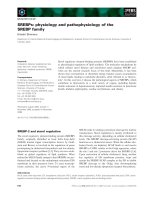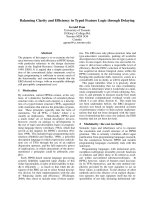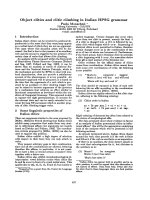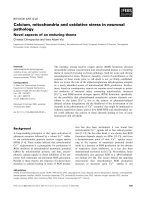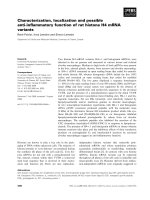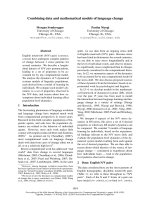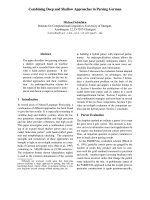Báo cáo khoa học: D-strand perturbation and amyloid propensity in beta-2 microglobulin ppt
Bạn đang xem bản rút gọn của tài liệu. Xem và tải ngay bản đầy đủ của tài liệu tại đây (405.23 KB, 10 trang )
D-strand perturbation and amyloid propensity in beta-2
microglobulin
Stavros Azinas
1,2
, Matteo Colombo
1
, Alberto Barbiroli
3
, Carlo Santambrogio
4
, Sofia Giorgetti
5,6
,
Sara Raimondi
5,6
, Francesco Bonomi
3
, Rita Grandori
4
, Vittorio Bellotti
5,6
, Stefano Ricagno
1
and
Martino Bolognesi
1
1 Dipartimento di Scienze Biomolecolari e Biotecnologie and CIMAINA, Universita
`
degli Studi di Milano, Milan, Italy
2 Department of Biochemical Sciences, University of Surrey, Guildford, UK
3 Dipartimento di Scienze Molecolari Agroalimentari, Universita
`
degli Studi di Milano, Milan, Italy
4 Dipartimento di Biotecnologie e Bioscienze, Universita
`
di Milano-Bicocca, Milan, Italy
5 Dipartimento di Biochimica, Universita
`
di Pavia, Pavia, Italy
6 Laboratori di Biotecnologie, IRCCS Fondazione Policlinico San Matteo, Pavia, Italy
Keywords
amyloidosis; beta-2 microglobulin; beta-
buldge; dialysis related amyloidosis; MHC I;
proline
Correspondence
M. Bolognesi, Dipartimento di Scienze
Biomolecolari e Biotecnologie and CIMAINA,
Universita
`
degli Studi di Milano, Via
Celoria 26, 20133 Milano, Italy
Fax: 00390250314895
Tel: 00390250314893
E-mail:
(Received 21 March 2011, revised 29 April
2011, accepted 4 May 2011)
doi:10.1111/j.1742-4658.2011.08157.x
Proteins hosting main b-sheets adopt specific strategies to avoid intermolec-
ular interactions leading to aggregation and amyloid deposition. Human
beta-2 microglobulin (b2m) displays a typical immunoglobulin fold and is
known to be amyloidogenic in vivo. Upon severe kidney deficiency, b2m
accumulates in the bloodstream, triggering, over the years, pathological
deposition of large amyloid aggregates in joints and bones. A b-bulge
observed on the edge D b-strand of some b2m crystal structures has been
suggested to be crucial in protecting the protein from amyloid aggregation.
Conversely, a straight D-strand, observed in different crystal structures of
monomeric b2m, could promote amyloid aggregation. More recently, the
different conformations observed for the b2m D-strand have been inter-
preted as the result of intrinsic flexibility, rather than being assigned to a
functional protective role against aggregation. To shed light on such con-
trasting picture, the mutation Asp53 fi Pro was engineered in b2m, aiming
to impair the formation of a regular ⁄ straight D-strand. Such a mutant was
characterized structurally and biophysically by CD, X-ray crystallography
and MS, in addition to an assessment of its amyloid aggregation trends
in vitro. The results reported in the present study highlight the conforma-
tional plasticity of the edge D-strand, and show that even perturbing
the D-strand structure through a Pro residue has only marginal effects on
protecting b2m from amyloid aggregation in vitro.
Database
Atomic coordinates and structure factors have been deposited in the Protein Data Bank under
the accession number
3NA4.
Structured digital abstract
l
Beta-2-microglo bulin bi nds to Bet a-2-micro globulin by flu orescence technology (View interaction)
l
Beta-2-microglobulin binds to Beta-2-microglobulin by mass spectrometry studies of com-
plexes (View Interaction 1, 2, 3)
l
Beta-2-microglo bulin bi nds to Bet a-2-micro globulin by el ectron microscopy (View interactio n)
Abbreviations
b2m, beta-2 microglobulin; C
m
, melting concentration; D53P, beta-2 microglobulin Asp53 fi Pro mutant; DRA, dialysis-related amyloidosis;
GdHCl, guanidine hydrochloride; MHC-I, class I major histocompatibility complex; TFE, trifluoroethanol; T
m,
melting temperature.
FEBS Journal 278 (2011) 2349–2358 ª 2011 The Authors Journal compilation ª 2011 FEBS 2349
Introduction
Intermolecular cross-b interactions are at the basis of
protein amyloid aggregation. In the cross-b structure,
b-strands belonging to different protein chains associ-
ate, giving rise to extended intermolecular b-sheets.
Because many known protein folds present solvent-
exposed b-strands at the edges of constitutive b-sheets,
the formation of an extended intermolecular b-sheet
structure resulting from cross-b aggregation of protein
chains might turn into a likely event. Fortunately, such
a threatening aggregation process is only sporadic
in vivo. It has been proposed that proteins adopt dif-
ferent strategies to prevent intermolecular b-b interac-
tions. Among these, the b-sheet edge strands tend to
be irregular, generally short or host-charged residues
that make them unsuitable for cross-b interactions,
thus promoting the monomeric state over aggregation
[1]. Therefore, introducing a b-bulge in an otherwise
linear edge b-strand may impair the amyloid aggrega-
tion of proteins hosting b-sheets, improving their solu-
bility [1].
Beta-2-microglobulin (b2m) is a 99-residue b-sand-
wich protein that is noncovalently associated as the
light chain of the major histocompatibility complex
class I (MHC I). b2m provides an example of how the
molecular protection strategies described above appear
to be applied; indeed, despite being a fully b-protein, it
is stable as a monomer in solution up to millimolar
concentrations [2,3]. In vivo, and under normal condi-
tions, b2m is degraded in the kidneys after dissociation
from MHC-I; however, patients suffering from kidney
failure and undergoing long-term hemodialysis accu-
mulate free b2m in their serum to concentrations that
are ten- to 50-fold higher than physiological concentra-
tions [4]. Such stress conditions result in dialysis-
related amyloidosis (DRA), a pathological state
whereby hundreds of grams of b2m amyloid fibrils are
deposited in the skeletal joints and bones, hampering
their functionality [5]. Several factors appear to trigger
the formation of b2m amyloid fibrils in vivo, with par-
ticular attention being focussed on the role played by
glycosaminoglycans and fibrillar collagen (type I) [6,7].
Conversely, in vitro, b2m amyloid aggregation can be
achieved using a variety of conditions, such as partial
acid denaturation, proteolytic treatment and the addi-
tion of various chemicals (e.g. SDS and trifluoroetha-
nol) [8].
b2m displays a typical immunoglobulin fold, where
two facing b-sheets (composed of strands ABED and
CFG, respectively) are linked by a disulfide bridge
buried in the protein core [9]. The D-strand (residues
50–57), which is one of the two edge strands in the
ABED b-sheet, shows a high level of conformational
variability in known b2m 3D structures. To date, b2m
presents a bulged D-strand in all MHC-I crystal struc-
tures. Asp53 comprises the b-bulge residue at the cen-
tre of the D-strand, being involved in two hydrogen
bonds to Arg35 of the MHC-I heavy chain [10]. Con-
versely, in the first reported crystal structure of iso-
lated monomeric wild-type b2m, the D-strand is
straight, and thus devoid of any b-bulge [11]. It was
proposed that such a regular edge strand is a structural
feature promoting fibril formation [11]. Several other
crystal structures of isolated monomeric b2m have
been determined subsequently and, in every case, the
D-strand b-bulge turns out to be absent, regardless of
the amyloidogenic propensity tested on each given var-
iant [12–16]. Conversely, the hexameric structure of the
b2m H13F mutant, which is suggested to resemble clo-
sely the early amyloidogenic intermediate, presents the
Asp53 b-bulge. Moreover, NMR studies indicate that
the b2m D-strand is very flexible in solution [3,17].
Taking all these data together, it was suggested that
the variety of conformations observed for the D-strand
provide evidence of a high level of structural adapt-
ability at this edge strand, and that the straight
D-strand conformation trapped in the crystal of mono-
meric b2m is not an obligate step in the amyloid for-
mation [16].
Despite several recent reports on b2m amyloid fine
structure, the location of residue 53 in mature fibrils
remains unclear. Recent evidence obtained by solid-
state NMR suggests that the structural b2m core is
conserved in the mature fibrils, whereas some parts of
the molecule are reorganized [18,19]. However, some-
what constrasting evidence on the role of residue 53 is
available: Asp53 is predicted to map at the center of a
long b-strand [20] and to be involved in intermolecular
interactions [19]. On the other hand, the side chain of
Asp53 was shown to be highly flexible and likely
located in a solvent-exposed region [21].
In this context, additional information on the role
played by b2m Asp53 bulge during amyloid formation
appears mandatory. In the present study, we report
the structural and biophysical characterization of the
b2m D53P mutant, which was engineered with the aim
of determing the role played by the conformational
properties of the D-strand in protecting b2m from
amyloid aggregation. Because Pro residues are known
b-breakers, the Asp fi 53Pro mutation was chosen to
code for a constitutive perturbation of the D-strand
b-structure. Our structural and biophysical results
show that the D-strand region structure is perturbed
by the mutation, yielding a b2m molecular variant that
is more stable than the wild-type protein. We also
Amyloid propensity in b2m D53P S. Azinas et al.
2350 FEBS Journal 278 (2011) 2349–2358 ª 2011 The Authors Journal compilation ª 2011 FEBS
show that such a region is highly adjustable and that
a shorter and conformationally less regular edge
D-strand does not prevent amyloid fibril formation,
although it does show partly altered aggregation kinet-
ics under specific in vitro conditions.
Results
D53P fold stability
To assess the conformational stability of the b2m D53P
mutant, both chemical and thermal protein unfolding
processes were monitored by CD. Chemical unfolding at
equilibrium was followed by CD in the far-UV region,
acquiring spectra at increasing guanidine hydrochloride
(GdHCl) concentrations. The data indicate that the
D53P mutant is slightly more stable than wild-type b2m
[melting concentration (C
m
)
D53P
= 2.3 m GdHCl
versus C
m wild-type
= 2.1 m GdHCl] (Fig. 1A); the cal-
culated free energies are: DG
ðH
2
OÞD53P
= 22.9 kJÆmol
)1
(m = 9.8 kJÆmol
)1
Æm
)1
) and DG
ðH
2
OÞwild-type
= 28.0
kJÆmol
)1
(m = 13.2 kJÆmol
)1
Æm
)1
). Temperature ramps
monitored by CD in the near- and far-UV regions con-
firm that the mutant is also thermally more stable than
wild-type b2m. The secondary structure of the D53P
mutant unfolds at a melting temperature approximately
6 °C higher than wild-type b2m [melting temperature
(T
m
)
D53P
= 67.4 °C, T
m wild-type
= 61.4 °C] (Fig. 1B).
Similarly, the near-UV spectra revealed a more stable
tertiary structure for the mutant relative to wild-type
b2m (T
m D53P
= 65.6 °C versus T
m wild-type
= 62.8 °C)
(Fig. 1C).
Crystal structure of D53P
The structure of the D53P mutant was solved at a
1.9 A
˚
resolution, with an R
work
value of 21.4% and an
R
free
value of 26.9% (Table 1); 98 out of 100 amino
acids are traced in the electron density and clear elec-
tron density is visible for Pro53 and the surrounding
region. The absence of extensive intermolecular con-
tacts in the crystal lattice confirms that the D53P
mutant was crystallized as a monomeric species, in
agreement with size-exclusion chromatography results
acquired during the mutant purification procedure
(data not shown). The 3D structure of the D53P
mutant matches closely the structure of wild-type b2m,
as observed in the MHC-I (Protein Data Bank code:
2BSS rmsd of 0.74 A
˚
for 93 ⁄ 98 Ca) and displays a
rmsd of 0.85 A
˚
for 90 ⁄ 98 Ca atoms relative to mono-
meric wild-type b2m (Protein Data Bank code: 1LDS).
The latter rmsd value reflects a shift of the AB loop,
which, in the D53P mutant, is tightly packed on the
rest of the protein, as in MHC I (Fig. 2A), instead of
protruding towards the solvent as in most monomeric
b2m structures (e.g. the wild-type b2m mutants at resi-
due 60) [11,13–16].
Fig. 1. (A) Unfolding titration curves (monitored by CD in the far-
UV region) of wild-type (WT) b2m (h) and D53P b2m mutant (
)as
a function of GdHCl concentration. (B, C) Thermal unfolding moni-
tored by CD in the far-UV (B) and near-UV (C) regions for wild-type
b2m (black) and D53P b2m mutant (gray).
S. Azinas et al. Amyloid propensity in b2m D53P
FEBS Journal 278 (2011) 2349–2358 ª 2011 The Authors Journal compilation ª 2011 FEBS 2351
The most notable structural adaptations of the
D53P mutant structure are not only found in the
D-strand, as expected, but also in the neighboring
loops. By contrast to the previously known b2m crys-
tal structures, where secondary structures are
conserved, the introduction of Pro53 disrupts the
N-terminal part of the D-strand, resulting in a CD
loop that is four residues longer than in wild-type b2m
(residues 43–53 ⁄ 43–49, D53P ⁄ wild-type, respectively)
(Fig. 2); the CD loop is also more exposed than in the
wild-type b2m (Fig. 2). The resulting D-strand starts
only after Pro53 but gains one additional residue at its
C-terminus compared to the wild-type protein (residues
54–57 ⁄ 50–56, D53P ⁄ wild-type, respectively). As shown
in Fig. 2B, the DE loop is composed of only three resi-
dues (residues 58–60 ⁄ 57–60, D53P ⁄ wild-type, respec-
tively) and, as a consequence, displays an overall
conformation clearly different from wild-type b2m. All
such readjustments affecting the D-strand region result
in the translation of the whole 53–57 segment one resi-
due ‘upstream’, such that residue ‘n’ of the D53P
mutant matches the site of residue ‘n ) 1’ in the wild-
type b2m structure (e.g. residue 56 on 55; Fig. 2C).
Notably, the region around the mutation site is not
involved in intermolecular contacts to any neighboring
molecule, indicating that the conformation of the
D-strand observed for the b2m D53P mutant is not
constrained by crystal contacts.
D53P amyloidogenesis in vitro
The propensity of the D53P mutant to form amyloid
fibrils in vitro was tested with two standard protocols:
one at pH 7.4 with 20% trifluoroethanol (TFE) and
one at pH 2.5. As shown in Fig. 3A,B, the mutant
gives rise to amyloid aggregates both at neutral and
acidic pH. However, at neutral pH, amyloid formation
is delayed by 24 h, although the D53P mutant reaches
eventually the same level of aggregation as the wild-
type protein; at low pH, the amyloidogenic processes
for the two proteins are indistinguishable (Fig. 3A).
Oligomerization of natively-folded D53P
Similar to a recent report for wild-type b2m and three
distinct DE-loop mutants [22], the D53P mutant was
analyzed by means of nano-ESI-MS under nondenatu-
rating conditions. The formation of soluble oligomers
was monitored under mild desolvation conditions, aim-
ing to favor the detection of noncovalent complexes
(Fig. 3C). The charge state distribution of the mutant is
narrow and consistent with a compact protein confor-
mation. Spectra deconvolution yields a molecular mass
of 11842 ± 0.5 Da for the D53P mutant, in keeping
with the theoretical mass of the engineered protein.
As also previously observed, the spectra display con-
centration dependence in the explored range (up to
60 lm) [22]. As the protein concentration increases, the
spectra of the D53P mutant reveal oligomer-specific
peaks corresponding to dimers, trimers and tetramers.
Such concentrations fall below the threshold (100 lm)
generally observed for unspecific protein aggregation
under electrospray conditions [23].
The nano-ESI-MS data indicate that the
Asp fi 53Pro mutation does not prevent the formation
of b2m soluble oligomers. Indeed, comparison of the
spectra shown in Fig. 3C with those of wild-type b2m
and the mutated variants previously reported [22]
shows that the aggregation propensity of the
mutant under nondenaturing conditions is somewhat
decreased, although not abolished. The effect of the
mutation is similar to that observed in the previously
tested W60G b2m DE-loop mutant [22]. This result is
consistent with the structural rearrangements in the
DE loop as a result of the Trp60 fi Gly mutation,
and with the notion that the DE loop plays an impor-
tant role mediating protein–protein interactions [22].
These data and other considerations indicate that,
under the in vitro conditions tested, the substitution of
Table 1. Data collection and refinement statistics for the crystal
structure of D53P mutant.
b2m D53P mutant
Beam line ESRF ID14-2
Space group P2
1
2
1
2
Unit cell edges (A
˚
, degrees) a = 29.1
b = 50.7
c = 71.2
Resolution (A
˚
) 26.91–1.9
R
merge
(%) 10.6 (56.9)
I ⁄ r 8.4 (2.4)
Completeness 99.2 (99.0)
Redundancy 4.2
Unique reflections 8702
Refinement
R
work
(%) 21.4
R
free
(%) 26.9
Number of atoms
Protein 820
Water 50
Ramachandran plot
Most favored region (%) 100
Allowed region (%) 0
Outliers (%) 0
Values in parentheses are for the highest resolution shell. R
merge
=
R |I ) <I>| ⁄ R |I| where I is the observed intensity and <I> is the
average intensity. R
work
= R
hkl
||F
o
| ) |F
c
|| ⁄ R
hkl
|F
o
| for all data, except
5%, which were used for R
free
calculation.
Amyloid propensity in b2m D53P S. Azinas et al.
2352 FEBS Journal 278 (2011) 2349–2358 ª 2011 The Authors Journal compilation ª 2011 FEBS
residue 53 with proline and the perturbation of the
b-structure in the D-strand may play only a very mar-
ginal role, if any, in protecting b2m from oligomeriza-
tion of natively-folded molecules.
Discussion
The present study reports the design and characteriza-
tion of the D53P b2m mutant, where a Pro residue
was engineered at the center of the D-strand. The aim
was to mimic and stabilize the b-bulge at residue 53,
as observed in the b2m crystal structures where the
protein is in a nonmonomeric state. Because the inser-
tion of a proline breaks the regularity of a b-strand as
a result of restrictions of the / and w angles, the
resulting (partial) loss of secondary structure was addi-
tionally expected to affect the overall b2m stability.
Nevertheless, the D53P mutant, whose crystal structure
indeed shows a shorter D-strand, starting just at
Pro53, turned out to be chemically and thermally more
stable than wild-type b2m (Fig. 1). A possible explana-
tion for such unexpected increased stability of the
Fig. 2. (A) Left: cartoon representation of wild-type b2m structure in MHC-I complex (Protein Data Bank code: 2BSS). The b-bulge on resi-
due 53 breaks the D-strand into two halves. Middle: cartoon representation of the D53P mutant with a shorter D-strand and an extended
and protruding CD loop. Right: monomeric wild-type b2m displays a regular D-strand. Residues 53 and 56 are shown as magenta sticks. (B)
b2m sequence with secondary structures relative to the structure of monomeric wild-type b2m (MON), D53P mutant (D53P), wild-type b2m
complexed in MHC I (MHC) and the secondary structures of fibrillar b2m (AMY) predicted by Debelouchina et al. [19]. b-strands C, D and E
are labeled as ssC, ssD, and ssE, respectively. The CD and DE loops are marked as lCD and lDE; B, b-bulge. Residue 53 is marked as X. (C)
Stereo representation of strands D and E and the loop inbetween. The structures of wild-type b2m in MHC-I (yellow) and the D53P mutant
(green) are superimposed.
S. Azinas et al. Amyloid propensity in b2m D53P
FEBS Journal 278 (2011) 2349–2358 ª 2011 The Authors Journal compilation ª 2011 FEBS 2353
Fibrillogenesis pH 7.4, 20% TFE
60
25
Fibrillogenesis pH 2.5
40
50
15
20
20
30
10
0
10
WT
D53P
0
5
0 50 100 150 200
WT
D53P
Time (h)
0 50 100 150 200
Time (h)
ThT fluorescence (a.u.)
ThT fluorescence (a.u.)
100
5 µM
40 µM 60 µM
15 µM
90
80
70
60
50
40
Intensity (%)
30
20
10
0
100
90
80
70
60
50
40
Intensity (%)
m/z
30
20
10
0
1000 1500 2000 2500 3000 3500
100
90
80
70
60
50
40
30
20
10
0
1000 1500
8+
11+
14+
17+
2000 2500 3000 3500
1000 1500 2000 2500 3000 3500
100
90
80
70
60
50
40
m/z
30
20
10
0
1000 1500 2000 2500 3000 3500
A
B
C
Fig. 3. (A) Fibrillogenesis of D53P mutant. Left: kinetics of fibril formation monitored by thioflavin T fluorescence for wild-type (WT) b2m
and D53P in 20% TFE at pH 7.4. Right: kinetics of fibril formation at pH 2.5. (B) Transmission electron microscopy images of amyloid fibrils
grown in 20% TFE of the D53P mutant (left) and wild-type b2m (right). (C) D53P mutant oligomerization under native conditions monitored
by nano-ESI-MS. The most intense peak of the monomer (d), dimer (
¤), trimer ( ) and tetramer ( ) is labeled by the corresponding symbol
and by the charge state in the final panel.
Amyloid propensity in b2m D53P S. Azinas et al.
2354 FEBS Journal 278 (2011) 2349–2358 ª 2011 The Authors Journal compilation ª 2011 FEBS
mutant may relate to the high regularity of the D53P
mutant structure (all residues of the refined protein
structure fall in the most favorite regions of the Rama-
chandran plot). Additionally, because Pro residues are
known to decrease the entropy of the protein-unfolded
state, an entropic contribution of Pro53 to the folding
equilibrium, and thus to mutant stability, may also be
considered [24,25].
The amyloid aggregation propensity observed for
the D53P mutant was also rather unexpected. The
D53P variant, displays the same kinetics of fibril for-
mation at low pH compared to the wild-type protein,
whereas, in 20% TFE at neutrality, fibril formation is
partly delayed, although, on completion of the aggre-
gation process, the amount of fibrils is similar
(Fig. 3A,B). Consistent with these data, under native
conditions and in a concentration-dependent manner,
the D53P mutant spontaneously generates oligomers,
analogously to the wild-type protein (Fig. 3C). In gen-
eral, a Pro residue can contribute to inhibit fibrillogen-
esis, as reported for the Alzheimer Ab peptide [26],
islet amyloid polypeptide [27] and mouse apolipopro-
tein A-II [28]. By contrast, Pro53 appears to be well
tolerated for b2m fibrillogenesis, which takes place to
the same extent under the in vitro conditions tested but
with somewhat delayed kinetics at 20% TFE (pH 7.4).
Thus, the results for fibrillogenesis in the present study
indicate that a constitutive b-bulge-like structure in the
b2m 50–55 region (a b-sheet edge strand) has a mar-
ginal effect in protecting against aggregation (native or
fibrillar), posing some basic questions on the necessity
of achieving a regular D-strand as a requirement for
the aggregation process.
To date, two contrasting hypotheses have been pro-
posed about the regularity of the D-strand in mono-
meric b2m in relation to fibril formation. Trinh et al.
[11] observed a regular D-strand in the crystal struc-
ture of isolated monomeric b2m, and suggested that
the removal of the Asp53 b-bulge is a necessary
step towards aggregation. More recently, Ricagno
et al. proposed that occurrence of a regular D-strand
is simply evidence of the flexibility and plasticity of
such a strand, and not directly related to amyloid for-
mation [16]. Indeed, recent structural studies have
shown that, regardless of the amyloid propensity of
the mutant considered, several b2m structures display
a straight D-strand, which is regularly hydrogen-
bonded to the neighboring E strand [13–16]. Further-
more, two b2m structures showing residue Pro32 in
trans conformation, are held to resemble the b2m amy-
loidogenic intermediate [12,29], present different con-
formations of the D-strand: a regular D-strand (in the
P32A mutant) [12] and a bulged D-strand (in the hexa-
meric structure of the H13F mutant) [29]. Within the
MHC-I complex, the b-bulge centred on b2m Asp53 is
favored by hydrogen bonds between Asp53 and resi-
due Arg35 of the MHC-I heavy chain [10]. Intrigu-
ingly, NMR data for monomeric b2m in solution show
that the stretch of residues corresponding to the
D-strand displays poor b-character, and the D-strand
region is highly flexible [3,17]. In summary, the b 2m
D-strand folds as a bulged strand upon interaction
with the MHC-I heavy chain, it is flexible in solution
and is a regular b-strand when b2m is crystallized as a
monomer (Fig. 2b). Hence, our D53P mutant crystal
structure, together with previously reported structural
evidence including the b2m solution NMR structure
[3,17], strongly suggests that the D-strand and the
neighboring b2m loops are highly flexible ⁄ adjustable,
and adopt different conformations depending on the
structural context.
Richardson & Richardson [1] suggested a number of
strategies that proteins hosting extended b-structures
may adopt to minimize the formation of unspecific
intermolecular b-sheets by association of edge b-strands.
Such strategies can be grouped into two main classes:
(a) geometrical irregularities, such as b-bulges, on edge
b-strands, hampering intermolecular backbone interac-
tions, and (b) inward-pointing charged side chains that
become trapped in the hydrophobic core of the fibril
upon aggregation. Lysines are particularly suitable for
such purpose as a result of their charged long and flex-
ible side chain; however, other bulky charged residues
have been observed in such role. Richardson & Rich-
ardson [1] show that inward-pointing charged residues
in b-sandwich proteins are often used against amyloid
formation. In this respect, the locations of Lys91 and
His51 within the b2m structure are interesting. Lys91
is positioned on the edge G-strand, facing the inner
side of the b-sandwich. Even though no supporting
experimental evidence is available, Lys91 is well posi-
tioned to play a protective role against intermolecular
cross-b interactions in the native protein. On the other
hand, the location of His51in the D-strand is intrigu-
ing: in native b2m, the His51 side chain points out-
wards, although, in the structures of both the P32A
mutant and the hexameric H13F mutant, His51 is
flipped and points inwards [12,29], a conformation
that appears perfectly suited to prevent edge-to-edge
aggregation.
In conclusion, the crystal structure, fibrillogenesis
and biophysical data reported in the present study,
when considered in light of the extensive structural
literature on b2m, show that the D-strand, at the edge
of the b2m ABED b-sheet, is endowed with wide
structural flexibility and plasticity. As a result, the
S. Azinas et al. Amyloid propensity in b2m D53P
FEBS Journal 278 (2011) 2349–2358 ª 2011 The Authors Journal compilation ª 2011 FEBS 2355
different conformations observed in different crystal
structures may simply highlight some of the conforma-
tions that can be accessed by the D-strand and stabi-
lized by a specific structural environment. Thus,
straight or bulged D-strands would represent just two
of the possible conformations that are not necessarily
more amyloidogenic or less, respectively, relative to
many others. Indeed, we show that the engineering of
a Pro residue at the center of the D-strand (a ‘brute
force’ approach introducing evident D-strand struc-
tural perturbations) has no (protective) effects relative
to the end products of fibrillogenesis, although it dis-
plays some kinetic effects under specific in vitro condi-
tions. Indeed, plasticity of the edge D-strand,
facilitating conformational adaptations to the fibril
structural environment, may be one of the leading fac-
tors promoting b2m amyloid aggregation.
Because D53P mutant ability to form fibrils is com-
parable to that of the wild-type protein, it is unlikely
that residue 53 in mature fibrils is located within a
long b-strand [19]. Rather, we propose that, in mature
b2m amyloid fibrils, residue 53 is located in a loop or
at the end of a strand, where (when mutated to Pro) it
would not interfere with intermolecular association
interactions. Such a consideration would be in keeping
with the results reported by Ladner et al. [21], who
suggested that residue 53 may fall in a loop region of
the mature amyloid fibrils.
Experimental procedures
Mutagenesis
The expression and purification of wild-type and mutant
b2m species was carried out as described previously [30].
Mutagenesis of Asp53 to Pro was performed by using the
QuikChangeÔ site-directed mutagenesis kit supplied by
Stratagene (La Jolla, CA, USA) as described previously [13].
The primers used were: forward, 5¢-GAAAAAGTGGAGC
ATTCACCGTTGTCTTTC AGCAAGGA C-3¢; reverse, 5¢-G T
CCTTGCTGAAAGACAACGGTGAATGCTCCACTTTT
TC-3¢.
CD spectroscopy
CD experiments were performed on a Jasco J-810 spectro-
polarimeter (Jasco Inc., Easton, MD, USA) equipped with
a Peltier device for temperature control. Protein was dis-
solved in 50 mm sodium phosphate (pH 7.4). The protein
concentration was 1.4 mgÆ mL
)1
(1 cm cell path) or
0.1 mgÆmL
)1
(0.1 cm cell path) for CD measurements in the
near- and far-UV regions, respectively. Temperature ramps
were carried out by increasing the temperature from 20 °C
to 95 °Cat50°CÆh
)1
(0.83 °CÆmin
)1
). T
m
was calculated as
the first-derivatives minimum of the traces recorded in the
near- (293 nm) and far-UV (202 nm) regions. Chemical
unfolding experiments were carried out recording spectra at
increasing concentration of GdHCl at 298 K. CD signals at
212 nm (i.e. the lowest readable wavelength in the presence
of GdHCl) were plotted versus the GdHCl concentration
and then fitted with a logistic equation (originlab, version
8.0; OriginLab Corporation, Northampton, MA, USA).
The unfolding curves were analyzed using a two-state
mechanism. Initially, unfolding curves for the NMU transi-
tion were normalized to the apparent fraction of the
unfolded form, F
U
, using the equation:
F
U
¼ðY À Y
N
Þ=ðY
U
À Y
N
Þð1Þ
where Y is the observed variable parameter, and Y
N
and
Y
U
are the corresponding values for the native and fully
unfolded conformations, respectively. The difference in free
energy between the folded and the unfolded state, DG, was
calculated by the equation:
DG
¼ÀRT ln K¼ÀRTln½F
U
=ð1 À F
U
Þ ð2Þ
where K is the equilibrium constant, R is the gas constant,
and T is the absolute temperature. The data were analyzed
assuming that the free energy of unfolding or refolding,
DG°, was linearly dependent on the GdHCl concentration
[31] (denoted by C):
DG
¼DG
ðH
2
OÞ
À mC¼mðC
m
À CÞð3Þ
where DG
ðH
2
OÞ
and DG° represent the free energy of
unfolding or refolding in the absence and presence of
GdHCl, respectively; C
m
is the midpoint GdHCl con-
centration required for unfolding or refolding; and m
stands for the slope of the unfolding or refolding curve
at C
m
. A least-squares curve fitting analysis was used
to calculate the values of DG
ðH
2
OÞ
, m and C
m
.
Crystallization and structure determination
The D53P b2m mutant was crystalized using the hanging-
drop vapor diffusion method. The crystallization reservoir
was composed of 26% poly(ethylene glycol) 4000, 20% glyc-
erol, 0.2 m ammonium acetate and 0.1 m sodium acetate (pH
5.6). The crystal-growth droplet was composed of 1.2 lLof
the mother liquor and 1.2 lL of protein solution
(8 mgÆmL
)1
). Crystallization experiments were performed at
294 K. Thin needle-crystals grown from a single nucleation
site (bushes) were obtained and were flash frozen using
mother liquor as cryoprotectant. X-ray diffraction data col-
lection was performed at 100 K on beamline ID14-2 (ESRF,
Grenoble, France). The D53P crystals diffracted up to 1.9 A
˚
resolution and diffraction data were processed using mosflm
Amyloid propensity in b2m D53P S. Azinas et al.
2356 FEBS Journal 278 (2011) 2349–2358 ª 2011 The Authors Journal compilation ª 2011 FEBS
and scala [32,33]. Phases were determined by molecular
replacement, using molrep [34] and the b2m W60G mutant
[13] (Protein Data Bank code: 2Z9T) as the search model.
The structure was then refined with refmac5 [35]. Model
building and analysis was performed with coot [36].
Amyloid fibril formation
Two different protocols were followed for b2m amyloid
aggregation. The first protocol was carried out at pH 7.4
by incubation of 100 lm b2m in 50 mm phosphate buffer,
100 mm NaCl (pH 7.4) in the presence of 20% TFE at
37 °C. The second was carried out at pH 2.5 by incubating
100 ll b2m in 50 mm sodium citrate, 100 mm NaCl (pH
2.5). In both cases, 20 lgÆmL
)1
of b2m fibril seeds were
added to start the fibrillogenesis. Measurements were con-
ducted in triplicate.
MS
Nano-ESI-MS was performed on a hybrid quadrupole-
time-of-flight instrument (QSTAR Elite; Applied Biosys-
tems, Foster City, CA, USA) equipped with a nano-ESI
source. Metal-coated borosilicate capillaries with a med-
ium-length emitter tip of 1 lm internal diameter (Proxeon,
Odense, Denmark) were used to infuse the samples. The
instrumental parameters applied were: declustering potential
80 V; ion spray voltage 1.1–1.2 kV; curtain gas 20 PSI. The
interface heater was turned off. In the oligomerization
experiments, lyophilized b2m was dissolved in Milli-Q
water (Millipore, Billerica, MA, USA) (at room tempera-
ture) at different final protein concentrations and spectra
were acquired within a few minutes.
Transmission electron microscopy
A10lL aliquot of suspended b 2m amyloids was adsorbed
on 200 mesh formvar ⁄ carbon copper grids; after 5 min, the
grids were washed with distilled water to remove buffer
salts and then negatively stained with 2% uranyl acetate.
Sample observation was carried over on a EFTEM Leo912
ab (Zeiss, Oberkochen, Germany) transmission electron
microscope at 80 kV, and digital images were recorded by a
Proscan 1K slow scan charge-coupled device (Proscan,
Lagerlechfeld, Germany).
Acknowledgements
This work was supported by Fondazione Cariplo,
Milano, Italy (NOBEL project Transcriptomics and
Proteomics Approaches to Diseases of High Sociomedi-
cal Impact: a Technology Integrated Network), by the
Italian MIUR (FIRB contract RBLA03B3KC_005), by
the EU grant EURAMY and by FAR (Fondo Ateneo
per la Ricerca) to R.G. We thank Ms Nadia Santo (Cen-
tro Interdipartimentale di Microscopia Avanzata, Uni-
versity of Milano, Milan, Italy) for technical support.
References
1 Richardson JS & Richardson DC (2002) Natural beta-
sheet proteins use negative design to avoid edge-to-edge
aggregation. Proc Natl Acad Sci USA 99, 2754–2759.
2 Morgan CJ, Gelfand M, Atreya C & Miranker AD
(2001) Kidney dialysis-associated amyloidosis: a molec-
ular role for copper in fiber formation. J Mol Biol 309,
339–345.
3 Okon M, Bray P & Vucelic D (1992) 1H NMR assign-
ments and secondary structure of human beta 2-micro-
globulin in solution. Biochemistry 31, 8906–8915.
4 Floege J & Ketteler M (2001) beta2-microglobulin-
derived amyloidosis: an update. Kidney Int Suppl 78,
S164–S171.
5 Gejyo F, Yamada T, Odani S, Nakagawa Y, Arakawa
M, Kunitomo T, Kataoka H, Suzuki M, Hirasawa Y,
Shirahama T et al. (1985) A new form of amyloid pro-
tein associated with chronic hemodialysis was identified
as beta 2-microglobulin. Biochem Biophys Res Commun
129, 701–706.
6 Relini A, Canale C, De Stefano S, Rolandi R, Giorgetti
S, Stoppini M, Rossi A, Fogolari F, Corazza A, Esposi-
to G et al. (2006) Collagen plays an active role in the
aggregation of beta2-microglobulin under physiopatho-
logical conditions of dialysis-related amyloidosis. J Biol
Chem 281, 16521–16529.
7 Yamamoto S, Yamaguchi I, Hasegawa K, Tsutsumi S,
Goto Y, Gejyo F & Naiki H (2004) Glycosaminogly-
cans enhance the trifluoroethanol-induced extension of
beta 2-microglobulin-related amyloid fibrils at a neutral
pH. J Am Soc Nephrol 15, 126–133.
8 Platt GW & Radford SE (2009) Glimpses of the molec-
ular mechanisms of beta2-microglobulin fibril formation
in vitro: aggregation on a complex energy landscape.
FEBS Lett 583, 2623–2629.
9 Becker JW & Reeke GN Jr (1985) Three-dimensional
structure of beta 2-microglobulin. Proc Natl Acad Sci
USA 82, 4225–4229.
10 Shields MJ, Assefi N, Hodgson W, Kim EJ & Ribaudo
RK (1998) Characterization of the interactions between
MHC class I subunits: a systematic approach for the
engineering of higher affinity variants of beta 2-micro-
globulin. J Immunol 160, 2297–2307.
11 Trinh CH, Smith DP, Kalverda AP, Phillips SE &
Radford SE (2002) Crystal structure of monomeric
human beta-2-microglobulin reveals clues to its
amyloidogenic properties. Proc Natl Acad Sci USA 99,
9771–9776.
S. Azinas et al. Amyloid propensity in b2m D53P
FEBS Journal 278 (2011) 2349–2358 ª 2011 The Authors Journal compilation ª 2011 FEBS 2357
12 Eakin CM, Berman AJ & Miranker AD (2006) A
native to amyloidogenic transition regulated by a back-
bone trigger. Nat Struct Mol Biol 13, 202–208.
13 Esposito G, Ricagno S, Corazza A, Rennella E, Gumral
D, Mimmi MC, Betto E, Pucillo CE, Fogolari F, Vigli-
no P et al. (2008) The controlling roles of Trp60 and
Trp95 in beta2-microglobulin function, folding and
amyloid aggregation properties. J Mol Biol 378,
885–895.
14 Iwata K, Matsuura T, Sakurai K, Nakagawa A & Goto
Y (2007) High-resolution crystal structure of {beta}2-
microglobulin formed at pH 7.0. J Biochem (Tokyo)
142, 413–419.
15 Ricagno S, Colombo M, de Rosa M, Sangiovanni E,
Giorgetti S, Raimondi S, Bellotti V & Bolognesi M
(2008) DE loop mutations affect beta-2 microglobulin
stability and amyloid aggregation. Biochem Biophys Res
Commun 377, 146–150.
16 Ricagno S, Raimondi S, Giorgetti S, Bellotti V & Bo-
lognesi M (2009) Human beta-2 microglobulin W60V
mutant structure: implications for stability and amyloid
aggregation. Biochem Biophys Res Commun 380, 543–
547.
17 Verdone G, Corazza A, Viglino P, Pettirossi F, Giorg-
etti S, Mangione P, Andreola A, Stoppini M, Bellotti V
& Esposito G (2002) The solution structure of human
beta2-microglobulin reveals the prodromes of its amy-
loid transition. Protein Sci 11, 487–499.
18 Barbet-Massin E, Ricagno S, Lewandowski JR, Giorg-
etti S, Bellotti V, Bolognesi M, Emsley L & Pintacuda
G (2010) Fibrillar vs crystalline full-length beta-2-micro-
globulin studied by high-resolution solid-state NMR
spectroscopy. J Am Chem Soc 132, 5556–5557.
19 Debelouchina GT, Platt GW, Bayro MJ, Radford SE &
Griffin RG (2010) Intermolecular alignment in beta(2)-
microglobulin amyloid fibrils. J Am Chem Soc 132,
17077–17079.
20 Debelouchina GT, Platt GW, Bayro MJ, Radford SE &
Griffin RG (2010) Magic angle spinning NMR analysis
of beta2-microglobulin amyloid fibrils in two distinct
morphologies. J Am Chem Soc 132, 10414–10423.
21 Ladner CL, Chen M, Smith DP, Platt GW, Radford
SE & Langen R (2010) Stacked sets of parallel, in-regis-
ter beta-strands of beta2-microglobulin in amyloid
fibrils revealed by site-directed spin labeling and chemi-
cal labeling. J Biol Chem 285, 17137–17147.
22 Santambrogio C, Ricagno S, Colombo M, Barbiroli A,
Bonomi F, Bellotti V, Bolognesi M & Grandori R
(2010) DE-loop mutations affect beta2 microglobulin
stability, oligomerization, and the low-pH unfolded
form. Protein Sci 19, 1386–1394.
23 Invernizzi G & Grandori R (2007) Detection of the
equilibrium folding intermediate of beta-lactoglobulin in
the presence of trifluoroethanol by mass spectrometry.
Rapid Commun Mass Spectrom 21, 1049–1052.
24 MacArthur MW & Thornton JM (1991) Influence of
proline residues on protein conformation. J Mol Biol
218, 397–412.
25 Matthews BW, Nicholson H & Becktel WJ (1987)
Enhanced protein thermostability from site-directed
mutations that decrease the entropy of unfolding. Proc
Natl Acad Sci USA 84, 6663–6667.
26 Wood SJ, Wetzel R, Martin JD & Hurle MR (1995)
Prolines and amyloidogenicity in fragments of the
Alzheimer’s peptide beta ⁄ A4 . Biochemistry 34,
724–730.
27 Abedini A & Raleigh DP (2006) Destabilization of
human IAPP amyloid fibrils by proline mutations out-
side of the putative amyloidogenic domain: is there a
critical amyloidogenic domain in human IAPP? J Mol
Biol 355, 274–281.
28 Kunisada T, Higuchi K, Aota S, Takeda T & Yamagi-
shi H (1986) Molecular cloning and nucleotide sequence
of cDNA for murine senile amyloid protein: nucleotide
substitutions found in apolipoprotein A-II cDNA of
senescence accelerated mouse (SAM). Nucleic Acids Res
14, 5729–5740.
29 Calabrese MF, Eakin CM, Wang JM & Miranker AD
(2008) A regulatable switch mediates self-association in
an immunoglobulin fold. Nat Struct Mol Biol 15,
965–971.
30 Esposito G, Michelutti R, Verdone G, Viglino P,
Hernandez H, Robinson CV, Amoresano A, Dal PiazF,
Monti M, Pucci P et al. (2000) Removal of the
N-terminal hexapeptide from human beta2-microglobu-
lin facilitates protein aggregation and fibril formation.
Protein Sci 9, 831–845.
31 Pace CN (1990) Measuring and increasing protein sta-
bility. Trends Biotechnol 8, 93–98.
32 CCP4 (1994) The CCP4 suite: programs for protein
crystallography. Acta Crystallogr A 50, 760–763.
33 Leslie AGW (1992) Recent changes to the MOSFLM
package for processing film and image plate data. Joint
CCP4 + ESF-EACMB Newsletter on Protein Crystal-
lography.
34 Vagin AA & Teplyakov A (1997) MOLREP: an auto-
mated program for molecular replacement. J Appl
Crystallogr 30, 1022–1025.
35 Murshudov GN, Vagin AA & Dodson EJ (1997)
Refinement of macromolecular structures by the
maximum-likelihood method. Acta Crystallogr A 53,
240–255.
36 Emsley P & Cowtan K (2004) Coot: model-building
tools for molecular graphics. Acta Crystallogr A 60,
2126–2132.
Amyloid propensity in b2m D53P S. Azinas et al.
2358 FEBS Journal 278 (2011) 2349–2358 ª 2011 The Authors Journal compilation ª 2011 FEBS
